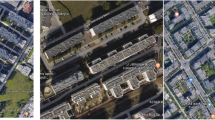Abstract
The topical issues of computational and experimental studies of wind effects of residential complexes in Moscow are reviewed on the examples of project building objects for verification of design solutions. The continued development of scientific school of architecture and construction aerodynamics is presented as well as its research on the aeration, urban air quality and pedestrian comfort. The results are various comfort criteria actually used in most affluent countries as a guide in the design of apartment houses. As a research method, physical modeling in a wind tunnel and numerical modeling in specialized software complexes are considered. Studies were conducted on the basis of Educational-Scientific-Production Laboratory for Aerodynamic and Aeroacoustic Test Building Constructions (ESPLab AATBC ) using the Large Research Gradient Aerodynamic Tunnel. The results of a comprehensive computational and experimental study of the effect of wind on urban areas are used to develop design solutions (landscaping and urban greening and others) for integrated land improvement to compensate for bioclimatic discomfort.
Similar content being viewed by others
References
Antoniou N, Montazeri H, Wigo H, Neophytou MKA, Blocken B, Sandberg M (2017). CFD and wind-tunnel analysis of outdoor ventilation in a real compact heterogeneous urban area: Evaluation using “air delay”. Building and Environment, 126: 355–372.
Blocken B, Stathopoulos T, van Beeck JPAJ (2016). Pedestrian-level wind conditions around buildings: Review of wind-tunnel and CFD techniques and their accuracy for wind comfort assessment. Building and Environment, 100: 50–81.
Cetin M (2015). Determining the bioclimatic comfort in Kastamonu City. Environmental Monitoring and Assessment, 187: 640.
Cetin M, Adiguzel F, Kaya O, Sahap A (2018). Mapping of bioclimatic comfort for potential planning using GIS in Aydin. Environment, Development and Sustainability, 20: 361–375.
Dunichkin IV, Zhukov DA, Zolotarev AA (2013). The effect of aerodynamic parameters of high-rise buildings on the microclimate and aeration urban environment. Industrial and Civil Construction, 9: 39–41. (in Russian)
Gaitani N, Mihalakakou G, Santamouris M (2007). On the use of bioclimatic architecture principles in order to improve thermal comfort conditions in outdoor spaces. Building and Environment, 42: 317–324.
Hu K, Cheng S, Qian Y (2018). CFD simulation analysis of building density on residential wind environment. Journal of Engineering Science & Technology Review, 11(1): 35–43.
Myagkov MS, Gubernskij JuD, Konova LI, Lickevich VK (2007). City, Architecture, Man and Climate. Moscow: Arhitektura-S. (in Russian)
Naboni E (2014). Integration of outdoor thermal and visual comfort in parametric design. In: Proceedings of the 30th International PLEA Conference, Ahmedabad, India.
Nazarova MV (2016). Wind-protective effectiveness of modular forest linear groups. The Collection of The I International Scientific and Practical Conference “Modern Ecology State Environment and Scientific Practical Aspects Rational of Natural Resources Problems of Agroecology”, pp. 973–976.
Oliveira S, Andrade H (2007). An initial assessment of the bioclimatic comfort in an outdoor public space in Lisbon. International Journal of Biometeorology, 52: 69–84.
Poddaeva OI, Buslaeva JS, Gribach DS (2014). Physical model testing of wind effect on the high-rise. Advanced Materials Research, 1082: 246–249.
Veremchuk LV, Yankova VI, Vitkina TI, Nazarenko AV, Golokhvast KS (2016). Urban Air Pollution, Climate and its Impact on Asthma Morbidity. Asian Pacific Journal of Tropical Biomedicine. 6: 76–79.
Weng Q (2003). Fractal analysis of satellite-detected urban heat island effect. Photogrammetric Engineering & Remote Sensing, 69: 555–566.
Acknowledgements
All tests were carried out using research equipment of The Head Regional Shared Research Facilities and unique scientific installation “Large Research Gradient Wind Tunnel” of the Moscow State University of Civil Engineering (National Research University).
Author information
Authors and Affiliations
Corresponding author
Rights and permissions
About this article
Cite this article
Dunichkin, I.V., Poddaeva, O.I. & Golokhvast, K.S. Studies and evaluation of bioclimatic comfort of residential areas for improving the quality of environment. Build. Simul. 12, 177–182 (2019). https://doi.org/10.1007/s12273-018-0495-z
Received:
Revised:
Accepted:
Published:
Issue Date:
DOI: https://doi.org/10.1007/s12273-018-0495-z




